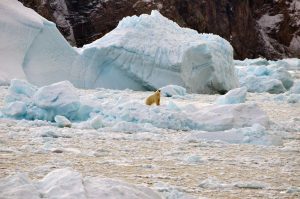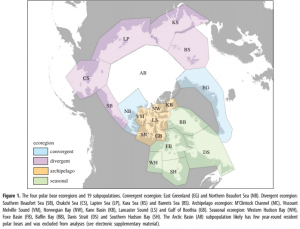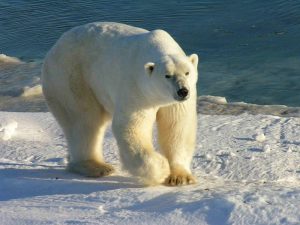Polar Bears are Vulnerable to Loss of Sea Ice
By Rachael Ragen

Polar Bear, https://sealevel.nasa.gov/ system/news_items/main_images/ 74_polarbear768.jpeg
Polar bears are currently facing a major problem: declining sea ice. As greenhouse gases continue to increase due to anthropogenic factors causing temperatures to rise and ice to melt. Since polar bears rely on sea ice as they search for prey, the decline in sea ice makes hunting much more difficult. The current population of polar bears is estimated to be 26,000 with 19 subpopulations in 4 ecoregions (Figure 2). It is very difficult to properly assess each subpopulation of polar bears as they live in extreme environments. Therefore, no global assessment has been done and the status of some subpopulations is unknown. The study by Regehr et al. aimed to look at the effect of sea ice decline on polar bears by determining the generation length, forming a standardized sea ice metric, and then using statistical models and computer simulations.

Map of Ecoregions, Regehr et al.
In order to determine the generation length, the authors looked at the age of female polar bears with a cub and found the average to be 11.5 to 13.6 years. Live capture data was used to determine these numbers. The upper level is used to account for variations in generation length.
A sea ice metric was determined using satellite data from 1979 to 2014. This data was used to establish the carrying capacity, which is the maximum amount of organisms the habitat can support, for the polar bears. Then the value found for K (carrying capacity) was used in linear models. This analysis generated predicted future values of ice as well, as the effect these values had on subpopulations. The ice decline was shown to affect all subpopulations.
The statistical models and computer simulations looked at the relationship between polar bear populations and sea ice over three generations using three different methods. First they assumed that changes in sea ice are directly proportional to changes in subpopulation abundance. This method was useful for populations with limited data. Second they looked at a linear relationship between ice and subpopulation abundance for subpopulations, although data was only available for seven of the nineteen. There was not shown to be a significant change due to variations in the status subpopulations as well as uncertainty in estimates of abundance. Lastly they again looked at a linear relationship between ice and population but for each of the four ecoregions. Some ecoregions showed a significant change, whereas others did not, showing that dynamics and biological productivity varies between subpopulations.
Table of data found, Regehr et al.
This study looked at the IUCN Red List’s guidelines for risk tolerance. The culmination of these studies showed that the first generation’s mean global population size was to decrease by 30%, the second by 4%, and the third by 43% (Table 1). Since there was shown to be a high risk of the population decreasing by 30% and a low chance of the population decreasing by 50% (Table 1), polar bears are classified as vulnerable.


